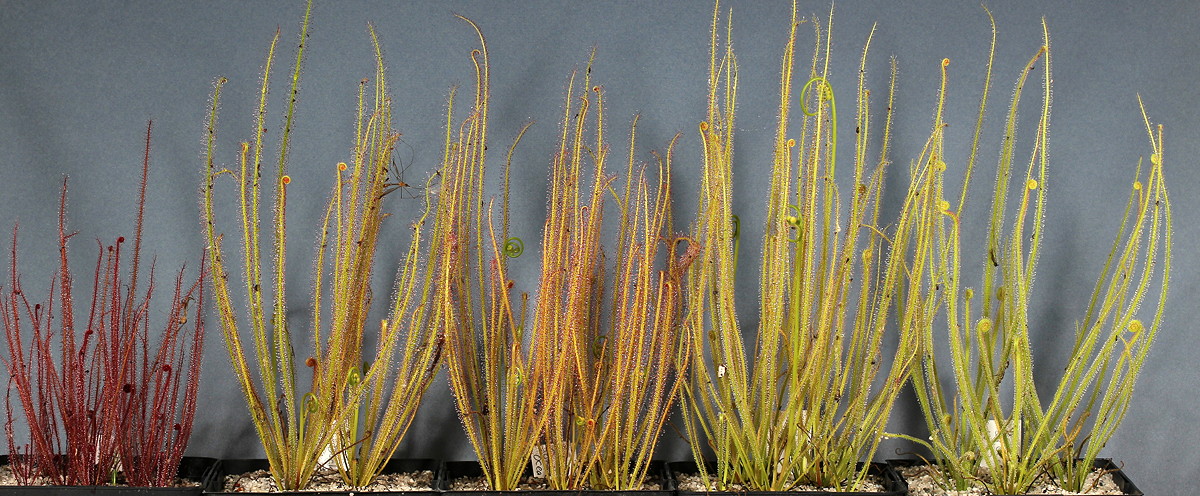
Drosera filiformis complex plants. From left to right: Drosera filiformis var. floridana, exceptionally red plant, Washington County, Florida. D. filiformis, Columbus County, North Carolina. D. filiformis, Ocean County, New Jersey. D. x californica 'California Sunset'. D. tracyi, Walton County, Florida. The plants were grown next to each other outside. All plants blooming size except the Drosera tracyi.
Drosera filiformis and Drosera tracyi are two closely related North American species. Drosera filiformis is found on the Atlantic coast from North Carolina to Nova Scotia along with a few populations in the Florida panhandle. The Florida plants are generally smaller and redder than the Atlantic coast plants and were given the name Drosera filiformis var. floridana. The ICPS Seed Bank has distributed seeds of Drosera filiformis var. floridana as "Florida all red", "Florida red", or simply "Florida". Drosera tracyi is found along the gulf coast from Louisiana to the Florida panhandle and southern Georgia. Both species form hibernacula in the winter although Drosera tracyi is found in an area generally considered warm temperate and may not survive a real winter.
If you can get Drosera filiformis and Drosera tracyi to bloom at the same time, hybrids are easy to make partly because Drosera tracyi flowers tend not to self pollinate very well. The hybrid between the two species called Drosera 'California Sunset' was produced by one of the founders of the ICPS. The origin of the hybrids Drosera 'Florida Giant', "Carolina Giant", and 'Portland Sunrise' is unknown. The hybrids tend to be much easier to maintain in cultivation than either of the parents and it is quite possible that many "Drosera tracyi" plants in cultivation have some parentage from Drosera filiformis. Hybrids between Drosera filiformis and Drosera tracyi may be referred to as Drosera x californica.
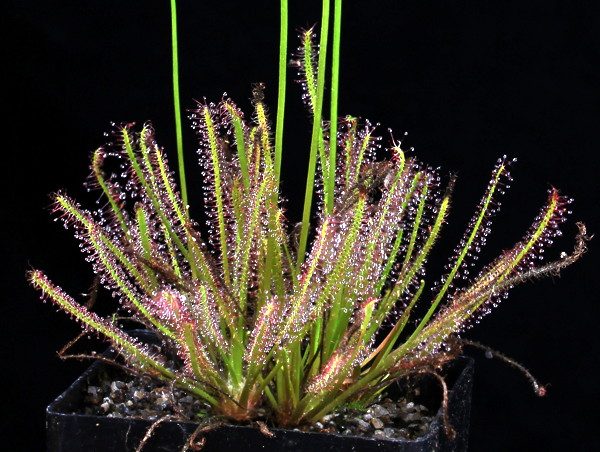
Drosera hybrida, Lake Absegami, New Jersey. The plant is no longer found at that location.
Drosera hybrida, the hybrid between Drosera filiformis and Drosera intermedia, may be grown the same way as the parents. That means if both parents are from New Jersey, the plant will grow like New Jersey Drosera filiformis var. filiformis. If the parents are Drosera filiformis var. floridana and Drosera intermedia New Jersey then the plants will be more winter hardy than the typical Florida plants.
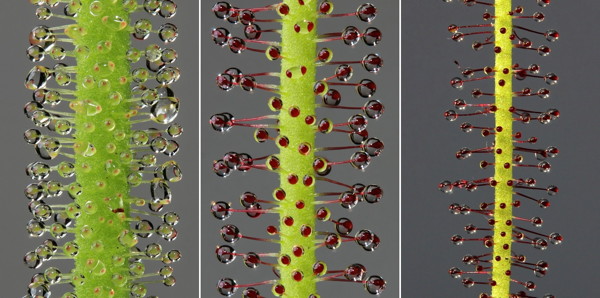
Leaves of Drosera filiformis complex plants close up: Drosera tracyi left, Drosera filiformis var. filiformis New Jersey center, Drosera filiformis var. floridana Florida right. The images are to scale.
The Atlantic coast Drosera filiformis requires a definite winter season to survive long term. You should grow them outside year round if you live within their natural range of USDA zones 6 and 7. If you live in a colder region, move the plants into a protected area after they have gone dormant. It is especially important they have protection from late spring frosts. If you live in zones 8 and 9 the plants should do well but may go dormant prematurely. If you live in zones 9 or warmer grow the Drosera filiformis var. floridana form outside. There are selected clones of Drosera filiformis var. floridana that will survive outside in zone 7, however most will not survive over winter in zone 8.
Drosera tracyi is found in USDA zone 9. It requires winter protection if grown in a colder climate and is especially sensitive to early and late freezes. We had trouble growing it outside in zone 9 in northern California which may have been a result of no real winter and long wet springs. Consider growing Drosera x californica 'California Sunset' or other hybrids between Drosera filiformis and Drosera tracyi instead. The hybrids can handle winter better than Drosera tracyi. Or grow Drosera tracyi in a cold greenhouse.
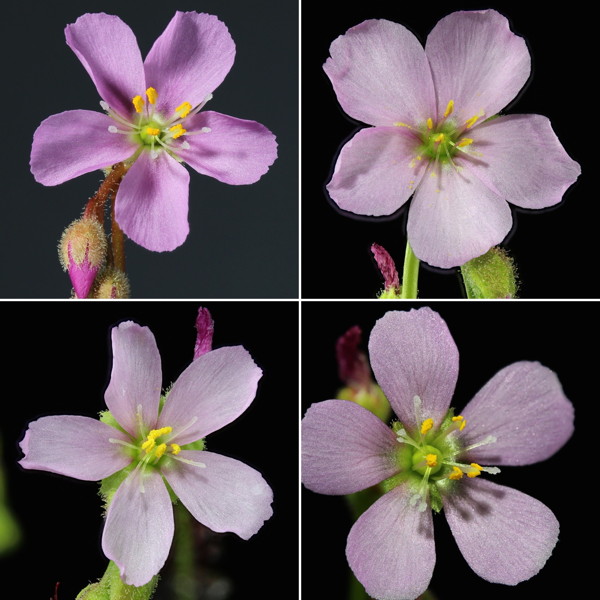
Flowers of Drosera filiformis complex plants close up: Drosera tracyi upper left, Drosera filiformis var. filiformis North Carolina upper right, Drosera filiformis var. filiformis New Jersey lower left, Drosera filiformis var. floridana Florida lower right. The images are not to scale.
If you want to grow Drosera filiformis in a terrarium, it is best to grow the Drosera filiformis var. floridana form. The seeds germinate without stratification and some of the plants do not go dormant. Most will form loose hibernacula that last a month or so before the plant starts growing again. The more you feed them the more likely they will not go dormant. This plant may be grown outdoors in summer but needs to be in a warm greenhouse or other location that does not freeze during the winter. In a terrarium tDrosera filiformis var. floridana may not develop the deep red color it would in full sun outdoors.
Seeds of Drosera filiformis and probably Drosera tracyi need a "winter" to germinate and it is best to do that during winter so the plants will be synchronized with the seasons. The usual way to do this is to give the seeds a few weeks of damp cold stratification. You can put pots planted with the seeds in the refrigerator for 4 weeks or just put them outside if you live where it gets cold during the winter. An alternative is to put the seeds in a small plastic bag with damp peat or finely chopped sphagnum moss in the refrigerator. The seeds and moss can be carefully spread over the surface of the soil in a pot after stratification. The best way to start these species from seed is to put pots planted with seeds outside in the winter and allow the seeds to sprout naturally. That way the new plants are immediately in phase with the seasons and will not go dormant prematurely.
No matter how you handle stratification, the seeds should not be buried when you want them to germinate. A pot with a 50:50 mix of peat and sand usually works well. Drosera filiformis and Drosera tracyi like large tall pots and can rot in the winter if the surface of the soil is too wet. You can mix extra sand into the top 1 cm of soil or even use pure sand the thickness of the hibernacula. The pots should always be sitting in water. Please see Sowing Seeds Step-by-Step for more details on starting seeds plus Growing cold temperate Drosera and Repot Cold Temperate Drosera in Spring for more information on growing the plants keeping in mind that Drosera tracyi is rather cold sensitive.
Make sure you feed your plants well if they are not catching many insects on their own. You can use rehydrated dried blood worms or foliar feed the plants with a dilute liquid fertilizer.
-- John Brittnacher
September 2001
Latest Update December 2019
For more information please see:
Robinson, James T. (1981) New CP Cultivar Received in 1980. Carniv. Pl. Newslett. 10(4):95 ( PDF )
Sheridan, Philip (1978) New Jersey Pine Barrens. Carniv. Pl. Newslett. 7(4):107-109 ( PDF )
Schnell, Don (1995) Drosera filiformis Raf.: One species or two?. Carniv. Pl. Newslett. 24(1):11-15 ( PDF )
Hummer, John H. (1998) A noteworthy Florida find: Drosera filiformis var. tracyi (Droseraceae). Carniv. Pl. Newslett. 27(3):89-90 ( PDF )
Rice, Barry A. (2011) The thread-leaf sundews Drosera filiformis and Drosera tracyi. Carniv. Pl. Newslett. 40(1):4-16 ( PDF )
Brittnacher, John (2018) Drosera filiformis, D. tracyi, and their hybrids: a photo essay. Carniv. Pl. Newslett. 47(3):92-100 (PDF)
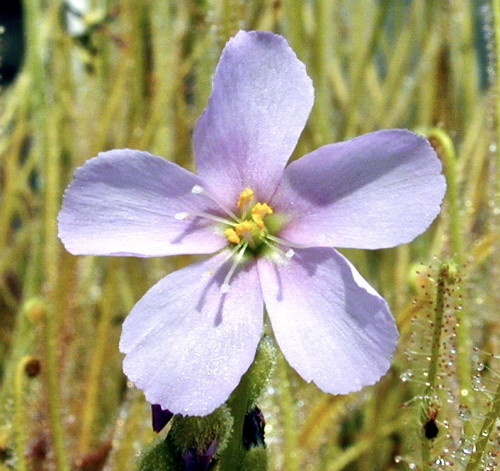
Drosera 'California Sunset' flower. This plant is a hybrid between Drosera filiformis and Drosera tracyi.
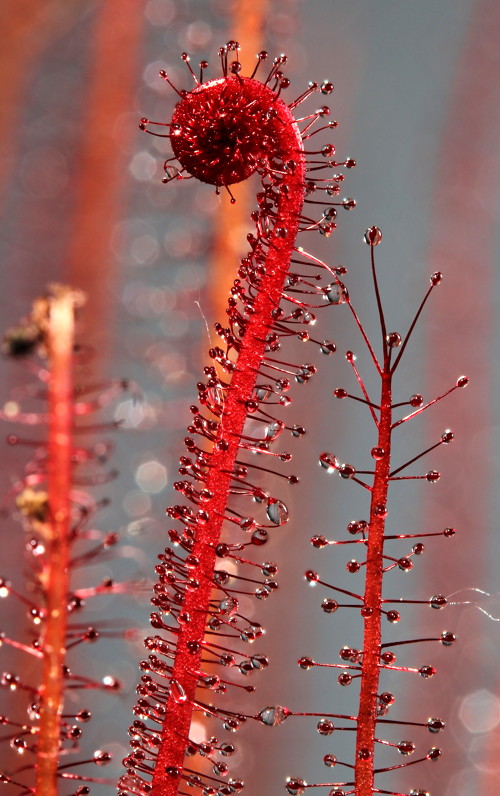
Drosera filiformis var. floridana is smaller and more delicate than Drosera filiformis var. filiformis.
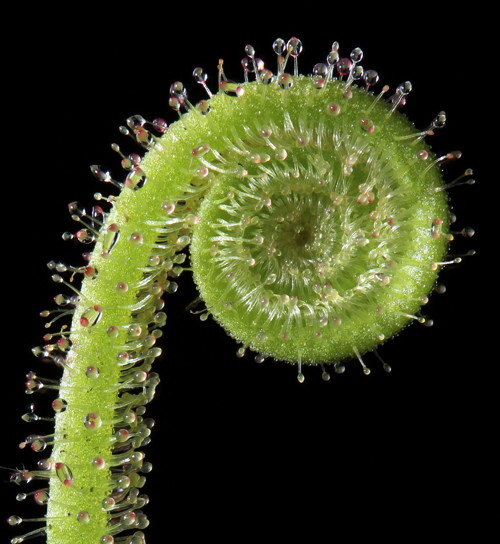
Drosera tracyi leaf unfurling.
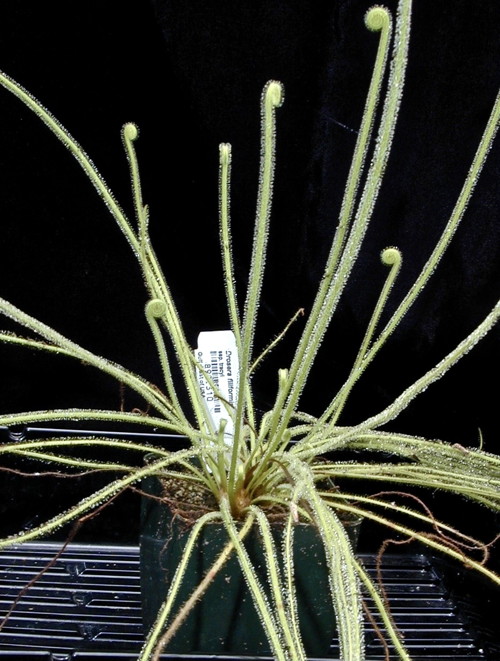
Drosera tracyi in a 8 cm pot.
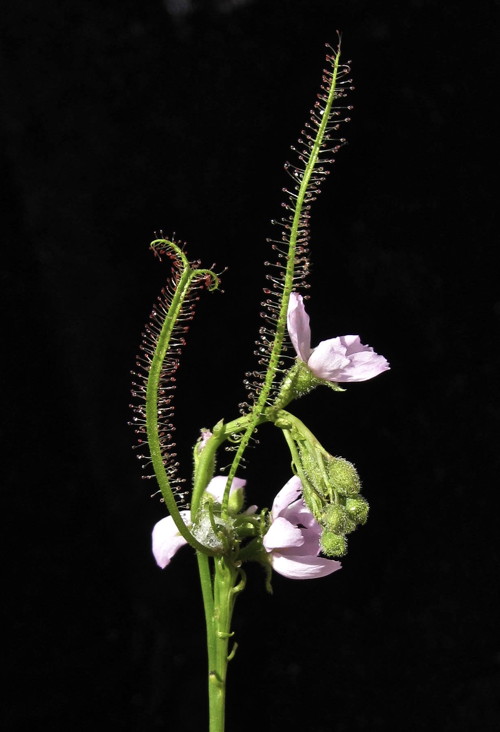
False vivipary on a Drosera filiformis scape. Note the scape is branched as is one of the leaves.
